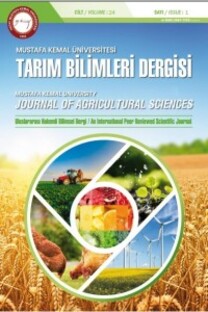Tarım topraklarındaki ağır metallerin kirlilik düzeylerinin belirlenmesi: Osmaniye örneği
Determination of heavy metal pollution levels in agricultural soils: the case of Osmaniye
___
- Anonim (2010) “27605 sayılı 08.06.2010 tarihli Toprak Kirliliği Kontrolü ve Noktasal Kaynaklı Kirlenmiş Sahalara Dair Yönetmelik (TKKY 2010/27605).
- Bolat İ, Kara Ö (2017) Bitki besin elementleri: Kaynakları, işlevleri, eksik ve fazlalıkları. Bartın Orman Fakültesi Dergisi 19(1): 218-228.
- Buczyńska A, Tarkowski S (2005) Environmental exposure and birth outcomes. International Journal of Occupational Medicine and Environmental Health 18(3): 225–232.
- Gönül İ, Delikanlı A, Serin S (2019) Yüksek pH Dayanımlı Yeni Tip Demir Şelat Formülünün Hazırlanması ve Yerfıstığı Üzerine Etkilerinin İncelenmesi. Çukurova Üniversitesi Mühendislik-Mimarlık Fakültesi Dergisi 34(3): 261-270.
- Jackson M L (1958) Soil chemical analysis prentice Hall. Inc., Englewood Cliffs, NJ, 498: 183-204.
- Khan NI, Owens G, Bruce D, Naidu R (2009). Human arsenic exposure and risk assessment at the landscape level: a review. Environmental Geochemistry and Health 31: 143–166. doi: 10.1007/s10653- 008-9240-3 PMID: 19172401.
- Khan MR, Khan MM (2010) Effect of varying concentration of nickel and cobalt on the plant growth and yield of chickpea. Aust. J. Basic Appl. Sci. 4(6): 1036–1046.
- Kırpık M, Büyük G, İnan M, Çelik A (2017) The heavy metal content of some herbal plants on the roadside of Adana-Gaziantep highway. Gaziosmanpașa Üniversitesi Ziraat Fakültesi Dergisi 34(1): 129-136.
- Kullu B, Patra D K, Acharya S, Pradhan C, Patra HK (2020) AM fungi mediated bio accumulation of hexavalent chromium in Brachiaria mutica-a mycorrhizal phytoremediationapproach. Chemosphere 258: 127337.
- Lavkor I, Çelik İ (2006) Osmaniye İli ve çevresinde bulunan farklı ana materyaller üzerinde oluşan topraklarda, toprak verimliliği-bitki besleme ilişkilerinin belirlenmesi. Çukurova Üniversitesi Fen Bilimleri Enstitüsü Toprak Ana Bilim Dalı Yüksek Lisans Tezi. Adana, 44-51.
- Lešková A, Giehl RF, Hartmann A, Fargašová A, von Wirén N (2017) Heavy metals induce iron deficiency responses at different hierarchic and regulatory levels. Plant Physiology 174(3): 1648-1668.
- Li Z, Li L, Chen GPJ (2005) Bioavailability of Cd in a soil– rice system in China: soil type versus genotype effects. Plant and Soil 271: 165–173.
- Lindsay WL, Norwell WA (1978) Development of a DTPA soil test for zinc, iron, manganese, and copper. Soil Science Society America Journal 42: 421-428
- Lu Y, Yin W, Huang LB, Zhang GL, Zhao YG (2011) Assessment of bioaccessibility and exposure risk of arsenic and lead in urban soils of Guangzhou City, China. Environmental Geochemistry and Health 33: 93–102. doi: 10.1007/s10653-010-9324-8 PMID: 20524051.
- Nakonieczny M (2007 Structural and functional adaptations of Chrysolina pardalina (Chrysomelidae; Coleoptera) to development on nickel hyperaccumulator Berkheya coddii (Asteraceae) – a comparative study with Chrysolinaher bacea. Silesia: University of Silesia Press.
- Naser HM, Sultana S, Mahmud NU, Gomes R, Noor S (2012) Heavy metal levels in vegetables with growth stage and plant species variations. Bangladesh J. Agric. Res. 36(4): 563-574.
- Oze C, Skinner C, Schroth A, Coleman RG (2008) Growing up green on serpentine soils: biogeochemistry of serpentine vegetation in the Central Coast Range of California. Appl. Geochem. 23: 3391–3403.
- Pandey J, Pandey U (2009) Accumulation of heavy metals in dietary vegetables and cultivated soil horizon in organic farming system in relation to atmospheric deposition in a seasonally dry tropical region of India. Environmental Monitoring and Assessment 148(1-4): 61-74.
- Rascio N, Navari-Izzo F (2011). Heavy metal hyperaccumulating plants: how and why do they do it? And what makes them so interesting? Plant Science 180(2): 169-181.
- Salmanzadeh M, Balks MR, Hartland A, Schipper LA (2016) Cadmium accumulation in three contrasting New Zealand soils with the same phosphate fertilizer history. Geoderma Regional 7(3): 271-278.
- Seven T, Can B, Darende BN, Ocak S (2018) Hava ve toprakta ağır metal kirliliği. Ulusal Çevre Bilimleri Araştırma Dergisi 1(2): 91-103.
- TAGEM (2018) Türkiye Tarım Topraklarının Bitki Besin Maddesi ve Potansiyel Toksik Element Kapsamlarının Belirlenmesi, Veri Tabanının Oluşturulması ve Haritalanması. TAGEM/TSKAD/13/A13/PO7/01-10.
- Tang L, Yasir H, Afsheen Z, Zulfiqar AS, He ZL, Bilal H, Hanumanth KG, Yang XE (2019) Characterization of fava bean (Vicia faba L.) genotypes for phytoremediation of cadmium and lead cocontaminated soils coupled with agro-production. Ecotoxicol Environmental Safety 171: 190–198.
- Tót G, Hermann T, Da Silva MR, Montanarella L (2016) Heavy metals in agricultural soils of the European Union with implications for food safety. Environment International 88: 299-309.
- Xu Y, Dai S, Meng K, Wang Y, Ren W, Zhao L, Teng Y (2018). Occurrence and risk assessment of potentially toxic elements and typical organic pollutants in contaminated rural soils. Science of the Total Environment 630: 618-629.
- Zhang XY, Lin FF, Wong MT, Feng XL, Wang K (2009) Identification of soil heavy metal sources from anthropogenic activities and pollution assessment of Fuyang County, China. Environ. Monit. Assess. 154: 439–449. doi: 10.1007/s10661-008-0410-7 PMID: 18597177.
- Zhu YG, Sun GX, Lei M, Teng M, Liu YX, Chen NC, Wang LH, Carey AM, Deacon C, Raab A, Meharg A, Wiiliams PN (2008) High percentage inorganic arsenic content of mining impacted and nonimpacted Chinese rice. Environmental Science & Technology 42: 5008-5013.
- ISSN: 1300-9362
- Yayın Aralığı: Yılda 3 Sayı
- Başlangıç: 1996
- Yayıncı: Mustafa Kemal Üniversitesi Ziraat Fakültesi
Hamza KUZU, Hayrettin KARADÖL, Ali AYBEK
Güney Karaman koyunlarının bazı üreme, besi ve süt verim özellikleri
Dilek TÜNEY BEBEK, Mahmut KESKİN
Pelleting pruning residues of mandarin for bio-energy
Metin DAĞTEKİN, Gürkan A. K. GÜRDİL
Carcass characteristics of rabbits raised in the semi-arid region of Nigeria
Emmanuel Abayomi ROTIMI, Hussaina Babba USMAN, Abduljalal Musa ALIYU
Effects of foliar sulfur applications in cotton crop on stomatal conductance under water stress
Derya KAZGÖZ CANDEMİR, Berkant ÖDEMİŞ
Uşak ilinde arı ürünlerinin tüketim durumları
Nuray ŞAHİNLER, Selçuk ÇETİNKAYA, Nesibe Özge TOY
İvesi koyunu yetiştiriciliğinde kızgınlık toplulaştırma ve süperovulasyon için bir model
Sabri GÜL, İbrahim Ethem ERDOĞAN
Veysi BÜRKÜK, Rüveyde TUNÇTÜRK
Cafer Tayyar ATEŞ, Tülay ÇİMRİN, SEMA ALAŞAHAN
Armut işletmelerinin teknik özellikleri: Antalya ili Korkuteli ilçesi örneği
